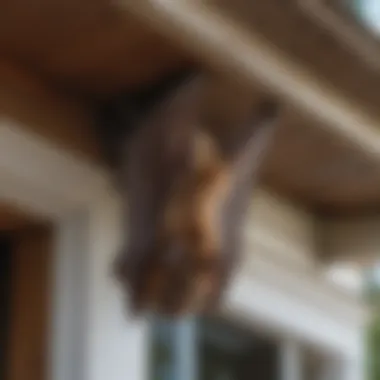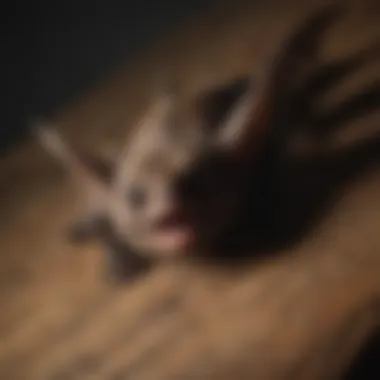Effective Strategies to Deter Bats from Your Porch


Intro
Dealing with bats can be confusing and sometimes troubling, especially when they decide to roost on your porch. Understanding their behavior and biology is crucial for any effective strategy aimed at deterring these creatures. This article aims to delve into methods to keep your porch bat-free while respecting these important animals.
Understanding Pests
Definition of Pests
In simple terms, pests are organisms that cause harm or discomfort to humans, animals, or crops. They often create issues in spaces where people live or produce food. Bats, while sometimes considered pests, are not inherently dangerous. They play significant ecological roles, including pest control and pollination. However, when they roost in unwanted areas, they can become a nuisance.
Importance of Pest Identification
Identifying a pest accurately is a vital step in approaching pest control. Different species of bats exhibit varying behaviors, preferences, and habitats. Certain species may prefer to roost in high, dark areas, making your porch an attractive option. Understanding what attracts bats helps in devising effective strategies to deter them.
Prevention Techniques
Home and Garden Preventative Measures
A proactive approach is the most effective way to manage bat presence on your porch. Consider the following:
- Seal Entry Points: Inspect for gaps in eaves, vents, and chimneys. Sealing these can prevent bats from entering.
- Lighting: Bats prefer dark spaces. Installing bright lights on your porch may make it less appealing for them.
- Remove Food Sources: Ensure no open garbage or food items are left outside that could attract insects, which in turn attract bats.
Seasonal Prevention Tips
Different seasons can influence bat behavior. For instance, during summer, bats are more active. Consider:
- Inspect Before Winter: Fall is when bats look for places to hibernate. Seal potential roosting spaces thoroughly.
- Regular Maintenance: Clean your porch area regularly. Remove any debris or organic matter that might attract insects.
Eco-Friendly Pest Control Solutions
Overview of Sustainable Practices
When addressing bat issues, it is essential to consider approaches that are both humane and effective. Sustainable practices do not harm bats while mitigating their intrusion. Options include spacing out deterrents and using natural barriers.
Natural Remedies and Their Effectiveness
Some individuals find success with natural solutions. Here are a few popular methods:
- Ultrasonic Repellents: These devices emit sounds that are unpleasant to bats but inaudible to humans.
- Essential Oils: Sprays containing peppermint or eucalyptus can deter bats due to their strong scents.
- Visual Deterrents: Reflective materials, such as aluminum foil, can make roosting less appealing.
"While bats may seem like a nuisance, they provide critical ecological benefits. It's vital to approach bat control with an informed perspective that prioritizes both human comfort and wildlife conservation."
By employing these strategies, homeowners can effectively reduce the likelihood of bats making their porches home. Always remember to balance effective control methods with the respect due to these creatures.
Understanding Bat Behavior
Understanding bat behavior is crucial for homeowners who wish to effectively deter these creatures from their porches. Bats are often misunderstood animals, often labeled as pests. However, their behavior and preferences provide insights that can lead to more effective and humane deterrent strategies. By recognizing why bats are attracted to specific areas, one can implement targeted measures to discourage their presence, without harming them.
Why Bats Choose Porches
Bats are selective in their roosting preferences. They are drawn to porches for several reasons. First, porches often provide shelter from the elements, giving bats a safe spot to rest. The overhangs and eaves of a porch can mimic natural caves or tree hollows, which are their typical resting places. Second, porches are usually located near potential food sources, like insect populations. Bats play an important role in controlling insect numbers, which inadvertently makes areas near human dwellings attractive to them.
Additionally, porches often have minimal human disturbance at night. This tranquility can appeal to bats seeking a safe place to roost. Understanding these factors gives a clearer picture of what attracts bats and how one can effectively create a less welcoming environment.
Common Species Found Near Homes
Several species of bats are commonly found near residential areas. The Little Brown Bat, known for its small size and rapid flight, is often in suburban settings. Another prevalent species is the Big Brown Bat, which is larger and more adaptable to changing habitats, including urban environments. These bats are primarily insectivores, feeding primarily on moths and beetles.
Each species has its own unique habits and ecological roles, and recognizing them can help in implementing the right deterrent methods. Some bats might prefer to hunt over water, while others might be found closer to terrestrial food sources. Understanding which species are present near your home can guide choices about which strategies to use and when to apply them for the best results.
Identifying the Signs of Bat Infestation


Understanding how to identify the signs of bat infestation is crucial for homeowners. Early detection can prevent a small issue from escalating into a significant problem. Bats, while benefiting the ecosystem, can pose health risks and property damage if they invade your living space. This section focuses on key indicators of their presence. Recognizing these signs provides you with actionable insights to take necessary steps promptly.
Visual Indicators of Bats
One of the most prominent signs of bats in your vicinity is the physical evidence left behind. Look for:
- Hanging bats: If you see bats hanging upside down, usually in dark corners or crevices, it indicates an established roost.
- Droppings: Small, dark droppings that resemble mouse feces may appear near entry points. They can accumulate in areas where bats frequently visit.
- Stains and marks: Check for any oily stains or rub marks on walls or entry points. These marks come from bats squeezing through tight spaces and can indicate pathways as they enter or exit.
Keeping an eye on these visual cues can aid in early detection of a bat problem, allowing you to take preventive measures before they become a greater concern.
Sounds Associated with Bats
Bats are nocturnal creatures, often most active during nighttime. Listening for certain sounds can also signal their presence. Sounds to pay attention to include:
- High-pitched squeaks and chirps: These vocalizations are common during bat activities, especially during mating season or when communicating.
- Flapping wings: The sound of flapping wings may be noticed during the evening hours when they begin to forage for insects.
- Scratching noises: Detecting scratching sounds within walls or ceilings can suggest that bats are nesting inside your home.
By tuning into these auditory indicators, you can gain insights into bat activity and respond accordingly.
Guano: The Bat Droppings
Bat droppings, known as guano, are often the most telling sign of a bat infestation. Recognizing guano is essential because it not only indicates bat presence but also serves as a potential health hazard. Here are some critical points:
- Appearance: Bat guano is small, dark, and appears crumbly. Offsetting its appearance, it often resembles mouse droppings but has a distinct shine when fresh.
- Location: Look for guano accumulations near roosting areas, particularly under porches or eaves. If left unchecked, it can lead to unsanitary conditions, often harboring harmful bacteria or parasites.
- Health Risks: Guano can carry diseases such as histoplasmosis, which can affect respiratory health in humans when spores are inhaled.
Recognizing and addressing bat guano quickly can mitigate potential health risks associated with their presence. Regular checks of your property, especially areas often overlooked, will help maintain a safe environment, free from bat infestations.
Preventative Measures
Taking preventative measures is crucial in the fight against bats settling on your porch. Implementing these strategies not only stops these creatures from roosting but also ensures a cleaner and more enjoyable outdoor space. By understanding bat behavior and their preferences, you can devise a plan that minimizes their appeal to your home.
Removing Food Sources
Bats are primarily insectivorous, often drawn to areas where food is readily available. To reduce their attraction, it is important to eliminate potential food sources.
- Insect Control: Regularly treat your yard for insects. Mosquitoes, moths, and other flying bugs often serve as dinner for bats. Use natural repellents or pesticides to control their populations without harming the ecosystem.
- Proper Waste Management: Ensure garbage cans are sealed tightly. Avoid leaving food scraps or waste out in the open. Even small food residues can attract insects, which in turn attract bats.
- Avoid Attracting Attractants: Make sure to tidy up areas around your porch, including fallen fruit, compost piles, and pet food left outside. All these can entice insects and, consequently, bats.
Cleaning and Maintenance Tips
Maintaining a clean environment around your porch sends the message that it is not a desirable habitat for bats. Regular cleaning and proper maintenance are simple yet effective strategies.
- Regular Sweeping: Frequently sweeping the porch and surrounding areas to remove debris can prevent insects from nesting, which helps eliminate food sources.
- Use Detergents: Clean with soaps and detergents to remove old scents and debris that might attract bats or their prey. This includes old nests or droppings that can signal a previous visit.
- Monitor Fixtures: Keep an eye on porch lights and outdoor fixtures. Bugs are often drawn to bright lights at night. Consider switching to yellow or sodium vapor lights, which are less appealing to insects.
Sealing Entry Points
Sealing off entry points is an effective way to deter bats. If they cannot access your porch or home, they are less likely to settle there.
- Inspect Your Home: Go around your porch to look for openings. Pay close attention to gaps around windows, doors, and roofing.
- Seal Gaps: Use caulk, foam, or wire mesh to seal potential entry points. Ensure the materials are durable and suitable for outdoor use.
- Close Off Attics or Overhangs: If you have attics or spaces commonly used by bats, installing a barrier can help prevent access.
Physical Barriers
Physical barriers serve as a practical solution to deter bats from settling on your porch. These methods directly influence bat behavior by limiting their access to preferred roosting areas. By effectively blocking entry points or creating an unwelcoming environment, homeowners can protect their property while ensuring they do not inadvertently harm these ecologically important creatures.
Netting and Screens
Installing netting or screens can be an effective barrier against bats. This method is non-invasive and allows homeowners to maintain airflow and visibility, while preventing bats from accessing the porch. Fiberglass mesh or nylon netting are ideal options that can be used to cover porches or eaves. The fine mesh size is crucial because it prevents bats from squeezing through, as they can fit through remarkably small openings.
When setting up netting or screens, ensure that there are no gaps or loose ends, as any openings could provide easy access. Additionally, it’s important to regularly inspect these barriers for wear and tear, replacing them as needed.
Using netting and screens is a humane way to keep bats at bay, allowing for coexistence while providing practical protection for your space.
Exclusion Devices


Exclusion devices are another effective way to keep bats out of your porch. These devices work by preventing bats from re-entering their roosting areas without harming them. One common type is the one-way door, which allows bats to exit but not return. This approach minimizes the disruption to the bat population and encourages them to relocate to suitable habitats elsewhere.
Before installing exclusion devices, it's important to conduct a thorough inspection of your property. Identify the entry points that bats use to access your porch. After confirming the occupancy, installation should occur at dusk when bats are typically out foraging. It is also essential to monitor the area after installation to ensure the devices are working effectively.
Lighting Adjustments
Adjusting the lighting around your porch can influence bat behavior significantly. Bats are nocturnal creatures, and they may avoid well-lit areas. Installing motion-activated lights or switching to brighter bulbs can deter them from approaching your porch. Selecting less attractive lighting options like yellow-tinted bulbs might help too, as they are less appealing to insects, which in turn reduces the food supply for bats.
Keep in mind that while bright lights can discourage bats, they might also disturb the natural nighttime environment. Thus, it is essential to find a balance that protects your porch while considering the ecological impact.
Implementing physical barriers is a crucial part of an effective strategy to deter bats. Utilizing netting, exclusion devices, and thoughtful lighting adjustments will create a less inviting space for these creatures, making your porch a safer environment.
Repellents and Deterrents
Effective repellents and deterrents are crucial in maintaining a bat-free porch. They offer a way to manage unwanted bat presence without harming the animals. Understanding what options are available helps you make informed decisions based on your unique situation. This section explores different types of repellents and their benefits, giving you various strategies to choose from.
Natural Repellents
Natural repellents are often favored for their humane and environmentally friendly properties. Using these methods can deter bats without causing them harm. Some common natural repellents include:
- Essential oils like peppermint and eucalyptus can deter bats due to their strong scent. This may disrupt their natural navigation and communication abilities.
- Vinegar can also be used as a repellent. By placing bowls of vinegar around your porch, you can help to keep bats away from the area.
- Strong odors from things like garlic or citronella can also be effective. Spraying these substances around the entrance points often makes the area less attractive to bats.
These methods are easy to implement and require little maintenance. However, effectiveness can vary, often depending on the surrounding environment and specific bat species in your area.
Commercial Bat Repellents
Commercial repellents are another alternative. These products are designed specifically for keeping bats away. It is essential to look for FDA-approved products to ensure safety and effectiveness. Some options include:
- Sprays with capsaicin, derived from hot peppers, can create an unpleasant sensation for bats when they come into contact with it.
- Chemical deterrent products utilize scents that irritate bats and encourage them to migrate elsewhere. These are considerably effective but can require frequent reapplication, especially during inclement weather.
- Granular repellents, often used in gardens, can also work on porches. The granules can be sprinkled around entry points to create an unfriendly environment for bats.
While commercial repellents are often effective, they may not be suitable for everyone. Make sure to read product labels carefully and follow usage instructions to avoid unwanted side effects.
Ultrasonic Devices
Ultrasonic devices have gained popularity in recent years. These gadgets emit high-frequency sounds, undetectable to humans, which can be disruptive to bats. They work by creating an unpleasant acoustic environment. Here are some points to consider:
Ultrasonic devices can be a discreet and non-invasive method for deterring bats from your porch.
- Ease of use: Just plug them in and let them do the work. They often cover a significant area, making them suitable for larger porches.
- Continuous operation: Many of these devices operate round-the-clock, ensuring a consistent barrier against bats.
- Non-toxic: Unlike chemical repellents, ultrasonic systems pose no risk to humans or pets, making them safer for family environments.
However, users should be aware that effectiveness may vary based on the specifics of the device and the local bat population. Regular testing may be needed to ensure they continue to function correctly.
In summary, utilizing a combination of natural, commercial, and ultrasonic deterrents can significantly enhance your efforts to keep bats off your porch. Each method bears its pros and cons; selecting the right approach depends on your priorities and unique circumstances.
Ecological Considerations
Understanding the ecological considerations surrounding bat populations is essential for anyone looking to deter these mammals from their porch. Bats are often considered pests, but their ecological contributions cannot be overstated. They play a vital role in regulating insect populations, which has significant implications for agriculture and human health. By recognizing the importance of bats in their natural habitats, homeowners can approach bat deterrence with a more informed perspective.
The Role of Bats in the Ecosystem
Bats serve multiple functions within ecosystems. They are prolific insectivores, consuming vast quantities of insects each night. This includes species that are harmful to crops and livestock, thus aiding agricultural productivity. A single bat can eat up to 1,200 mosquito-sized insects in an hour. This is beneficial for maintaining a balanced ecosystem and contributing to pest control.
Moreover, some bats are also pollinators. Certain species, such as the Mexican long-nosed bat, are critical for the pollination of plants like agave, which is essential for the production of tequila. Additionally, bats help in seed dispersal, promoting plant diversity in their habitats.
Bats contribute to global food systems through pest control, pollination, and seed dispersal.
Balancing Pest Control and Wildlife Conservation
When addressing bat infestations, it is crucial to strike a balance between effective pest control and the conservation of wildlife. Many homeowners may feel the need to eliminate bat colonies due to noise, droppings, or health concerns. However, understanding local regulations on bat species protection is important. Many species are protected under laws such as the Migratory Bird Treaty Act.
Humane strategies should be prioritized in pest control efforts. This may involve using exclusion tactics rather than lethal approaches, ensuring that bats can move to alternative roosting spots without harm. Such methods can include sealing entry points during non-breeding seasons when bats are less likely to be present. This respectful approach supports wildlife conservation efforts while allowing homeowners to manage their properties effectively.


In summary, by appreciating the ecological role of bats and taking conscientious steps to deter them humanely, homeowners can mitigate conflicts while supporting biodiversity in their communities.
Legal Considerations
Addressing the presence of bats on your porch requires a careful understanding of legal elements involved in bat management. This consideration is crucial for homeowners who wish to deter bats humanely without breaking local wildlife laws. While many see bats only as pests, their ecological benefits cannot be disregarded. Thus, the intersection of pest control and wildlife conservation necessitates a keen awareness of local legal frameworks regarding bats.
The following aspects illustrate why it is important to comprehend legal considerations in this context:
- Protection Status: Many bat species are protected by local, state, or federal laws. These laws may restrict methods available for removal or exclusion. Ignoring these regulations can lead to legal action or fines.
- Seasonal Restrictions: Certain jurisdictions may enforce seasonal restrictions on bat exclusion. For example, bats are often breeding in spring and summer. Attempting to remove them during this period can be illegal.
- Reporting Requirements: In some cases, homeowners may be required to report bat infestations to wildlife authorities. This helps monitor bat populations and conservation efforts.
In summary, understanding the legal considerations is paramount. It ensures that homeowners take appropriate actions without infringing on regulations protecting these nocturnal creatures.
Understanding Local Laws on Bats
Before taking any steps to manage bats on your porch, familiarize yourself with local legislation. This means checking both state and municipal laws.
- Research Local Regulations: Start by looking for wildlife management resources on your state’s or county’s official website. Many regions publish guidelines for handling wildlife issues.
- Consider Local Wildlife Agencies: Reach out to local wildlife offices or conservation groups for advice. They often have specific rules on how to handle bat encounters. These agencies can provide valuable insight into local bat species and their conservation status.
Always verify the best practices and rules applicable to your specific area to avoid unnecessary legal troubles.
Consulting Professionals for Assistance
When dealing with a bat issue, sometimes the most pragmatic approach is to consult professionals. Professional pest control services often possess expertise in wildlife management. They can assist in dealing with bats legally and humanely.
- Pest Control Services: Choose companies that specialize in humane bat extraction. They will know the local laws and follow appropriate procedures while managing bat populations.
- Wildlife Rehabilitation Experts: Another option is to consult wildlife rehabilitators familiar with bat behavior and habitat. They can offer guidance and possibly assist if you find injured bats.
- Avoid DIY Approaches: Many homeowners consider do-it-yourself approaches, but this can sometimes escalate the situation or violate laws. Relying on professionals ensures compliance and ethical treatment.
When to Seek Professional Help
When dealing with the challenge of bats on your porch, understanding when to seek professional help is essential. Although many deterrents and preventative measures can be managed independently, sometimes the situation exceeds what can be effectively handled through personal efforts. Recognizing the severity of the infestation is crucial.
If a few bats are observed occasionally, strategies can often be implemented without expert consultation. However, if the bats have established a roosting site, the dynamics change significantly. Bats can reproduce quickly, leading to larger populations that can become overwhelming for homeowners to manage. That's when professional assistance becomes a viable option.
"Considering the time and potential risk involved, contacting professionals ensures a comprehensive understanding of the situation and a structured approach to addressing the problem."
Assessing the Severity of the Infestation
To assess the severity of an infestation, start by observing bat activity patterns. Do you notice consistent sightings? Is there a significant presence of droppings or any physical damage to your property? Examining these signs provides clarity on the level of concern.
- Frequent Behavior: If bats return nightly or appear in increased numbers, this indicates a roost nearby.
- Guano Accumulation: The presence of guano, or bat droppings, can signify a persistent issue. It is worth noting that guano can come with health risks.
- Structural Assessment: Look for openings or cracks that could be potential roosting sites. In this case, engaging with professionals can provide insights about the structural integrity of your home.
Understanding these factors will help you decide if immediate action is needed.
Choosing the Right Pest Control Service
Once you determine the need for expert intervention, selecting the right pest control service is paramount. Not all pest control agents possess the necessary expertise in bat removal. Proper care is required to handle this situation, given the ecological importance of bats. Here are some steps to consider:
- Research: Seek out companies that specialize in wildlife control. Familiarity with bat behavior is critical.
- Verify Credentials: Ensure the pest control service is licensed and insured. Proper credentials signify professionalism and adherence to legal regulations.
- Ask About Methods: Inquire about humane removal techniques and post-removal prevention strategies from the company. This aligns with eco-friendly practices and maintains the ecological balance.
- Read Reviews: Research customer feedback and testimonials. These insights can help gauge the reliability and effectiveness of a service.
Making informed decisions when seeking professional help can lead to significantly more effective outcomes in deterring bats from your porch.
The End
In addressing the challenge of bats on your porch, effective strategies play a crucial role in maintaining both comfort and safety in your home environment. Understanding why these creatures are drawn to your living spaces is essential. Adopting practical measures can significantly reduce encounters without causing harm to the bats.
Summarizing Effective Strategies
To effectively deter bats, several strategies can be employed. First, consider physical barriers such as netting or screens that can keep bats out while still allowing fresh air in. Sealing entry points is another preventive method. Ensure that gaps and cracks in your porch structure are addressed to eliminate potential roosting locations.
Next, maintaining cleanliness on your porch is important. Remove any food sources, like uncovered trash or pet food, that might attract bats. Regular cleaning routines help discourage them from returning.
Using deterrents can also prove beneficial. Natural repellents or commercially available options can be applied to areas where bats tend to congregate. Lastly, employing ultrasonic devices may help to create sound environments that are uncomfortable for these creatures without disturbing your family.
Encouraging Responsible Management
It is vital to approach bat management with a responsible mindset. Balancing pest control and wildlife conservation impacts both your immediate environment and broader ecological health. Bats offer numerous ecological benefits, such as pest control and pollination, which should be respected even while managing their presence around our homes.
Practice humane solutions, avoid harmful extermination methods, and strive to educate your neighbors about bats. By doing so, you contribute to a more informed community and help create awareness that can lead to better solutions in the long term. Encouraging responsible management ensures that you protect both your home and the essential functions these creatures serve in nature.



